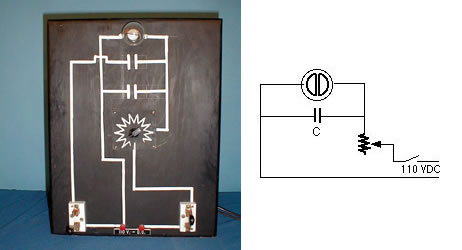Demos: 6C-03 Flasher Circuit

A neon lamp is connected in parallel with the capacitor in an RC circuit. When the voltage across the capacitor rises to approximately 80V, the neon lamp flashes, the capacitor discharges through the lamp, the voltage drops to about 60V, causing the lamp to go out. The cycle repeats. R and/or C may be adjusted to change the flash frequency.
Directions: Close the switch and wait for the bulb to flash. Let flash several times to get an approximate measure of the frequency. Then change R or C to get a different frequency. The room lights may need to be dimmed to see the neon bulb flash.
Suggestions for Presentation: Discuss the properties of a neon bulb, i.e. that it does not flash until a critical voltage is reached. How might that voltage rise be controlled? Have them think RC circuits. Then how might the flash rate be controlled?
Applications: Flashers of various kinds.
Last Updated: Nov 30, 2023 11:25 AM